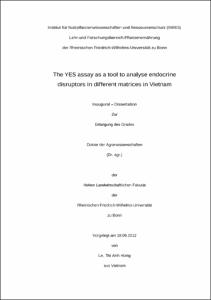The YES assay as a tool to analyse endocrine disruptors in different matrices in Vietnam

The YES assay as a tool to analyse endocrine disruptors in different matrices in Vietnam

| dc.contributor.advisor | Clemens, Joachim | |
| dc.contributor.author | Le, Thi Anh Hong | |
| dc.date.accessioned | 2020-04-17T12:49:27Z | |
| dc.date.available | 2020-04-17T12:49:27Z | |
| dc.date.issued | 16.11.2012 | |
| dc.identifier.uri | https://hdl.handle.net/20.500.11811/5137 | |
| dc.description.abstract | Endocrine disrupting compounds (EDCs) or endocrine disruptors have been a global concern for many years due to their negative impact on wildlife and human health. The main sources of EDCs in the environment are humans and animals. EDCs can appear in a number of environmental matrices such as wastewater, surface water, manure, sludge, sediments, etc. Several techniques are available for analysing EDCs, each with its advantages and disadvantages. When selecting a method, the purpose of the study should be considered, especially an EDC monitoring programme with many samples. In Vietnam, environmental pollution, especially of surface water, is currently increasing. This is an important issue examined in many studies but information on EDCs is still lacking. The studies reported in this thesis used the YES assay as a tool to analyse EDCs in different matrices in Vietnam. These included surface water, river sediments, the liquid and solid phases of septage slurry and biogas slurry and wastewater. The Saigon River showed upstream of HCMC EDC values below the limit of detection (LOD). But in the City and downstream the range of EDCs was 0.02-6.2 ng E2eq/L in the dry season and 0.33-1.17 ng E2eq/L in the rainy season. EDC concentrations in sediments ranged from < LOD (upstream) to 0.28 ng E2eq/g (dw). Total EDCs in septage slurry ranged from 57.92 to 1506.81 ng E2eq/L, with EDC concentrations in the liquid phase ranging from 11.87 to 184.29 ng E2eq/L and those in the solid phase from 2.21 to 99.16 ng E2eq/g (dw). EDC concentrations in influent from biogas plants fed with animal manures were in the range 56.98-903.91 ng E2eq/L. Most EDCs were found in the solid phase (77.9-98.7%). The EDC level in fresh cow manure was 3.63 ± 2.23 ng E2eq/g (dw) and decreased by 95.3±3.52 % of the initial value within 2 months of drying or vermicomposting. The largest EDC discharge into surface waters in the Mekong Delta, Vietnam, was from humans (156 kg E2eq/year), followed by animals (23kg E2eq/year). Wastewater from fish processing companies contributed the least EDCs, 0.025 kg E2eq/year. The results presented in this thesis can be used to devise strategies to reduce EDC discharges to surface waters in Vietnam. | en |
| dc.language.iso | eng | |
| dc.rights | In Copyright | |
| dc.rights.uri | http://rightsstatements.org/vocab/InC/1.0/ | |
| dc.subject.ddc | 630 Landwirtschaft, Veterinärmedizin | |
| dc.title | The YES assay as a tool to analyse endocrine disruptors in different matrices in Vietnam | |
| dc.type | Dissertation oder Habilitation | |
| dc.publisher.name | Universitäts- und Landesbibliothek Bonn | |
| dc.publisher.location | Bonn | |
| dc.rights.accessRights | openAccess | |
| dc.identifier.urn | https://nbn-resolving.org/urn:nbn:de:hbz:5n-30276 | |
| ulbbn.pubtype | Erstveröffentlichung | |
| ulbbnediss.affiliation.name | Rheinische Friedrich-Wilhelms-Universität Bonn | |
| ulbbnediss.affiliation.location | Bonn | |
| ulbbnediss.thesis.level | Dissertation | |
| ulbbnediss.dissID | 3027 | |
| ulbbnediss.date.accepted | 18.09.2012 | |
| ulbbnediss.fakultaet | Landwirtschaftliche Fakultät | |
| dc.contributor.coReferee | Rieser, Armin |
Files in this item
This item appears in the following Collection(s)
-
E-Dissertationen (1118)




